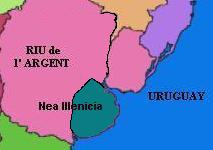Nea Illenicia

| |
| Language: | Costanice, Greek (Katharevousa) |
| Languages: | |
| Official: | Costanice |
| Others: | Arabic (Levantine dialects), Aragonese, Greek (demotic), Guaraní, various Het languages (esp. Querandí), Mapuche, Ukrainian |
| Independence: | from Rio de La Plata |
| Declared: | 194X |
| Recognized: | 194Y |
| Currency: | drakma (₯) |
Nea Illenicia is populated by refugees from Greece speaking a peculiarly evolved form of Greek known as Costanice. Their government is socialist, and the state church is Greek Orthodox.
More info forthcoming.
Administration
Government
Nea Illenicia's government is socialist, with ecotopic influences and notably a state religion in the form of Greek Orthodoxy.
Administrative Divisions
LIST OF ADMINISTRATIVE DIVISIONS
History
The History of Nea Illenicia begins with the Ottoman invasion of the Byzantine Empire. Ferdinand in a symbolic gesture offers citizenship and refuge for any displaced Hellenes. A small group of Greeks took this option, settling for a time in Pamplona and Barcelona. The first group of Costanicos arrived in 1472[1].
By the 17th century these small enclaves had blossomed into the thousands. With the push of colonization, Aragon did as many of her fellow countries in Europe did, and offered the undesired elements of society a chance at a new life, in a new land. The Hellenes were one of these groups, as they had both rejected Aragonese, Latin Rite Catholicism, and had refused to leave their insular societies to become a part of the larger Aragonese whole.
While the Aragonese had settled many different locations as exploration outposts, there were no permanent colonies until the Costanicos came to South America. The first shiploads arrived in 1604, and Nea Illenicia is founded. Settling at Zalsan Agre (Mar de Plata) the Costanicos were left largely alone, as later Aragonese settlers opted for the Rio de La Plata. Aragonese settled Buenos Aires, Montevideo, Rosario, Santa Fe and Cordoba. Castilian settlers arrived and settled Santiago del Estero and Asunción. Castilians and Aragonese met, for better or worse, at Cordoba and Asunción.
What was esteemed by the Costanicos to be an independent nation was by the 18th century firmly under the control Aragon. By the 19th century the decolonization process began, with independece for Chile, Autonomy for Rio de La Plata and integration for New Granada. Nearly all Aragonese holdings were placed in Rio de La Plata with the exceptions of Uruguay and Paraguay.
Until the 20th Century this meant that Nea Illenicia was under the rule of the Republic of the Rio de La Plata. The Nea Illenicians didn't rest easily under the the rule of the Argentos, and revolted during the Second Great War. This move was supported by the government of Araucania and Patagonia, eager to have a buffer state between themselves and their neighbor, especially at the cost of the neighbor's territory.
In the 1920's, a man, inspired by the teachings of Marx, Lenin and Trotsky stepped to the political fore. Zeoduero Efeseyo[2] developed a form of socialism that bordered on SNORism in its fanaticism to the Orthodox Church, but staunchly adhered to so many of Marx's tenets that it can only be considered Communism. This new political ideal is referred to as efeseyism. It is also different from regular communism in the ecological leanings. One should not compare the efeseyism to ecotopianism, as a Nea Illenician would decry the ecotopians capitulation to capitalist processes.
Geography
GENERAL DESCRIPTION OF THE COUNTRIES GEOGRAPHY
Borders
- North, West, South: Riu de l'Argent
- East: Atlantic Ocean
Economy
The economy of Nea Illenicia has been described as nearly "utopic", a term that is rarely applied to any form of Communism.
Culture
RELEVANT ASPECTS OF THE NATION'S CULTURE
Languages
The state language is Costanice, a daughter language of Koine Greek. It has been heavily influenced by Spanish in phonology and vocabulary, though less in syntax and morphology. It retains much of the Koine Greek case system, though the verbal system has been extensively remodeled.
Religion
The state religion is the Orthodox Church of Zalsan Agre (commonly called Illenician Orthodox or New World Greek Orthodox), which is an autocephalous church headed by the Metropolitan of Zalsan Agre. The church receives a subsidy from the government, and until recently (198X ?) government officials had to be members of the Orthodox Church. However, the Metropolitan himself is not considered a government official, rather the Metropolitan together with the national synod appoint the Minister of Religion.
The Argentine junta of Esperanza Rios moved in Catholic transplants to build up a loyal settler base in the country. After the independence of the country in 2015, most left with the Argentine military. In recent years the government has become more open to non-Orthodox religions, allowing members of other religious bodies to run for office and form political parties if they register with the state. Before the occupation, the Catholic Social-Democratic Alliance had several seats in parliament. The populace is now distrustful of the entire Catholic world after a brutal, 12-year long occupation by a militantly Catholic country pushed the religion on the population.
See also
Jaspax.com Website hosting all linguistic data collected on Costanice.
